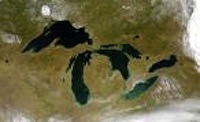Activists tell Quebec premier to remember Fukushima and shut their nuke
Watch a video of a Greenpeace Canada action here.
Dr. Gordon Edwards, President of the Canadian Coalition for Nuclear Responsibility, and Canadian co-chair of the Great Lakes United Nuclear-Free/Green Energy Task Force, has written up a short backgrounder on how hugely expensive it would be to "refurbish" Gentilly, the atomic reactor in Quebec located on the St. Lawrence River, through which the waters of the Great Lakes ultimately flow into the Atlantic Ocean. A political cartoon in a Quebec newspaper jokes about the Greenpeace occupation of the Quebec premier's office. Dr. Edwards explains and translates: the premier says to the Greenpeace occupiers, "It's gonna be safe! Gentilly-2 will be rebuilt by Quebec engineers using Quebec concrete!" [But] his assistant, aware of all the scandalous infrastructure problems in Montreal, with bridges falling apart and concrete overpasses collapsing -- including a big chunk of concrete that just fell at the garage of the Olympic Stadium -- says "Psst! This might not be the best time...."





 March 7, 2012
March 7, 2012

